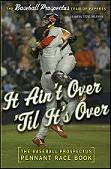Just read an interesting article on the physics involved in pitching published online at the American Scientist. In particular here are a few of the things I didn't know.
1. The theory that Bernoulli's prinicpal is responsible for the deflection of a ball thrown with spin has not been verified experimentally. I thought I had read in Adair that the Magnus force was caused by the decrease in pressure on one side of the ball due to the spin and seams. The authors of this article say that conservation of momentum is a better explanantion whereby the turbulent air generated by the spin is deflected in the opposite direction of the ball's "break".
2. Wind tunnel experiments have not shown that a four-seam grip causes a fastball to drop less than a two-seam grip. The authors speculate that it is a visual illusion. Their theory is that a major league fastball thrown with a four-seam grip does not provide the visual clues that a fastball thrown with a two-seam grip does. With a two-seam grip, the two seams are visible 20 times a second or so which causes a visual pulse or "flicker" that the batter can perceive. The four-seam grip produces a pulse at a higher frequency that that cannot be perceived.
3. Although it makes sense, I hadn't thought about the fact that a curve ball that breaks vertically is more difficult to hit than one that break horizontally. This is the case since the bat's sweet spot is about 4 inches long and just 1/3 of an inch high
4. Dynamic visual acuity - the ability to perceive information in moving objects - is not correlated with static visual acuity. Therefore a person could have geat eyesight in the view of an optometrist but be lousy at picking up the spin on a breaking ball (that must have been my problem). The authors note that:
"get a feel for the range in dynamic visual acuity, consider that most of us can read the label on a phonograph record turning at 33 revolutions per minute, but this would be about the limit of our capabilities. The great Boston Red Sox hitter, Ted Williams, could read one turning at 78 revolutions per minutes, which is far beyond the dynamic visual acuity of the average person."
5. The four-seam grip on a slider is what causes the red dot to appear in the upper right hand quadrant of a slider thrown by a right-handed pitcher. Using a two-seam grip eliminates the dot and therefore gives less information to the hitter.
Their conclusion is that...
"the pitcher should use a four-seam grip for fastballs and curveballs to remove the perceptual clue of the two red stripes and the flicker. Then, he should use the two-seam grip for the slider, to remove the clue of the red dot. These techniques could make a fearsome pitcher even more difficult to hit."
Monday, May 23, 2005
The Physics of Pitching
Posted by
Dan Agonistes
at
12:56 PM
![]()
Subscribe to:
Post Comments (Atom)
125x125_10off+copy.jpg)



No comments:
Post a Comment